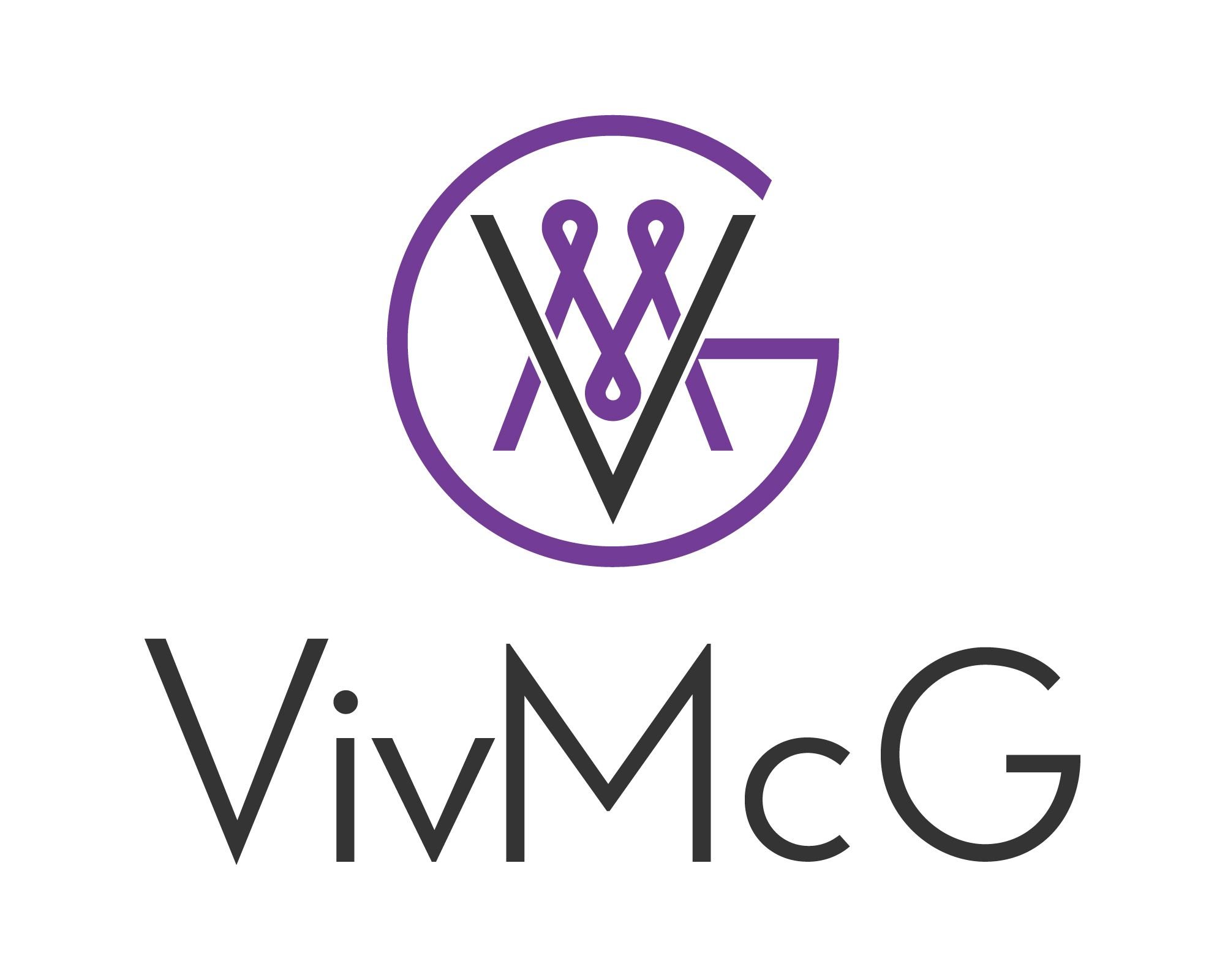start monday with gratitude
week 18
Welcome to Week 18, lovely soul.
Below you'll find the video and video transcript introducing you to this week's quote and musings.
Scroll further and you'll discover this week's daily exercises, high vibe tune, and downloadable wallpapers.
video transcript
When we turn to psychology to determine what role the eyes play in revealing our emotions, we can learn a lot. According to Psychology Today, the eyes provide a lot of information pertaining to a person’s emotional state.
When a person is worried and feeling sad, they’ll naturally furrow their brow which, in turn, makes their eyes look smaller. In contrast someone who is happy will raise their eyebrows which makes their eyes look large and bright, hence the term “bright-eyed”.
That’s not all the eyes reveal. They are the truthsayers of the face. When someone is smiling, you can tell if their smile is genuine or fake by simply looking at their eyes. The eyes can’t and don’t lie. It’s easy to fake a smile if we only consider the role the mouth plays. But only when we truly and genuinely smile do our eyes take on the true expression of our happy feelings; they crinkle at the corners and take on a brightness, a sparkle.
The eyes express what the heart and soul are feeling.
A life filled with gratitude is a life that appreciates, recognises and acknowledges all the goodness, all the blessings, all the miracles that happen every single day, no matter how big or how small. Such a sense of gratitude is reflected in our eyes as the eyes are not only the truthsayers of our face but the mirrors of our heart and soul.
Have you ever looked into the eyes of, or seen a picture of, a Buddhist monk, I wonder? Have you ever seen the twinkle, the gentleness, the kindness, the glow of brightness that shines form their eyes?
Buddhist monks use mindfulness to cultivate a life lived with gratitude and where you see evidence of that the most, is in their eyes.
When you cultivate a habit of gratitude, it sings from your heart and your soul, and is most visible in your eyes.
Let your eyes sing the gratitude you feel and express every day.
daily gratitude practice
monday
Today you’ll need the help of a mirror, preferably a full-length mirror. Although this week’s quote focused on the sweetness of the eyes, we’re going to start this week’s exercises by looking at the body as a whole as that will teach us how to understand changes in the body, before we look at the subtle changes in the eyes.
Standing in front of the mirror, take a few deep cleansing breaths to centre yourself and bring yourself into a neutral space.
When you feel ready, remember a time when you felt really angry. Perhaps someone spoke to you in a way that made you angry or a situation you got caught up in made you angry.
Recall everything you can about that time and verbalise everything you felt.
Watch your body as you do so.
How does your stance change? Do you lean more towards the mirror? Do you cross your arms? Does your complexion turn more red?
Spot as many changes as you can.
After you have done this, close your eyes and take a few deep cleansing breaths to centre yourself and bring you back to a neutral state.
Now recall a time when you felt grateful about something someone did or how, for example, a situation turned out.
Again, verbalise exactly how you felt as a result of this and watch how you body reacts and changes.
Does your stance change? What’s the expression on your face?
Again take note of how your body responds to the emotion you are feeling.
Can you see quite stark differences in how you hold your body and how you body reacts to each of the different emotions?
tuesday
Again, today, you’ll need a mirror. However, it doesn’t need to be full-length. You’ll only be observing your eyes.
Standing in front of the mirror, take a few deep cleansing breaths to centre you and bring you to a neutral state. Then open your eyes and make eye contact with yourself. You may feel a little uneasy to start with. Maintain a gentle eye contact with yourself for a few moments until you feel more relaxed.
Then, for the next few minutes, I invite you to recall a memory that made you feel really sad, hurt and upset. Whlst maintaining eye contact and looking only into your eyes and not anywhere else on your face, express in words how that person or situation made you feel.
Watch and witness any changes in your eyes.
Do they become more narrow? Do you, perhaps, see tears begin to form?
Witness how your eyes change as you recount that memory.
When you are finished, close your eyes for a few moments and take a few deep cleansing breaths to centre yourself and bring you back to a place of neutrality.
When you feel ready, open your eyes again and look into only your eyes as you recall, out loud, a memory of a person or situation that brought you joy. A person or situation for which you feel grateful because of the joy you experienced as a result.
Express out loud how you felt during that time. Perhaps express your gratitude for this time. Try to recall as much detail as possible.
Watch closely how your eyes change. The changes may be subtle.
See what changes you notice.
wednesday
Today we’re going to repeat yesterday’s exercise, only today rather than verbalising out loud how your felt on each occasion, I invite you to simply recall each occasion in your mind. Simply remember everything that happened and how you felt.
Try to recall as much detail as possible.
And as you are recalling these memories, one at a time, look into your eyes and see how they change.
Do they change in the same way that they changed when you verbalised your experiences? Or are the changes more subtle? Can you see a clear difference in your eyes when you’re angry or sad compared to when you’re feeling joy and gratitude?
Are you now more mindful of just how much information our eyes reveal about how we’re feeling and our energetic vibration?
thursday
We're taking our practice even further today. Again, we’ll be using a mirror and looking at how our eyes react.
This exercise may take some practising as what I invite you to do may not come easily.
First centre yourself and bring yourself to a neutral state by taking a few deep cleansing breaths.
Then I invite you to hold your body, your expression in a way that shows you’re feeling really angry. You might want to recall a person or situation that made you feel really angry in order to hold this stance and expression.
Keep your stance and expression the same. However, change your thoughts to happy, joyous, grateful thoughts. Again, you might want to recall a memory to do so.
It may be challenging. However, how your body is held and the expression on your face should not change.
Do you notice a difference in your eyes?
Now look at your whole face.
Can you see how your eyes don’t match the expression on your face?
And look at your whole body.
Can you, again, see how your eyes don’t match the stance you’re holding?
When you changed your thoughts from ones of anger to ones of joy, you were able to maintain your stance and even the expression on your face. However, your eyes could not lie. Your eyes changed. It may have been a subtle change. However they did change and with the previous exercises you’ve done this week, you should have noticed the difference and, indeed, the disconnect.
Try this exercise again only this time hold you body and facial expression in a way that shows you’re really happy as you think happy thoughts. Then looking into your eyes, change your thoughts to sad or angry thoughts whilst keeping your stance and expression.
Do your eyes, again, change?
friday
Today you’ll need a volunteer but don’t tell then what you’re doing.
You’ll also want to recount a story (it can be true or make-believe) that starts off super happy and joyful but has a very sad ending. So, before speaking to your volunteer, think what tale your’re going to recount and work through the details – it this is a made-up story, you want it to be believable so your volunteer will react naturally.
When you’re ready I invite you to observe your volunteer’s eyes.
Start telling your volunteer the story. Give as much detail as possible to make them feel part of the story.
Start recalling (or creating) the happy, joyful scene and then gradually move to the story in a different and downward direction, one that leads to a very sad ending.
Watch their eyes the whole time.
How do their eyes change throughout the story?
Can you tell what they’re feeling each tie their eyes change?
Are the changes subtle are can you clearly see their eyes change?
saturday
Today we’re heading outside for a walk. It can be a walk in the country or a walk through town. It doesn’t matter, so long as you know you’ll meet people, strangers along the way.
As you walk, be observant of strangers approaching you from a bit of a distance.
Look at their body language and their facial expression and quickly determine if you believe their emotion to be high vibrational, such as happy, joyful, or low vibrational, such as sad, forlorn.
Then as they come closer to you catch a glimpse of their eyes and see how their eyes reflect the same emotion you already perceived them to be carrying.
sunday
Head back out today where you know you’ll pass by other people.
As people pass you by, look at their eyes and determine who is carrying a low vibrational emotion such as sadness or anger, and who’s carrying a high vibrational emotion such as happiness or joy.
For anyone who’s eyes tell you they’re unhappy, sad, angry, worried, any lower vibrational emotion, I invite you to cheer them up by simply smiling at them, both with your face and your eyes.
You may not catch a change in their eyes as they register your smile as they may already have walked past you. It doesn’t matter. Simply give thanks that, through this week’s exercises, you can now see those who need support in life, those who are feeling down and tired, those who are experiencing a low vibration, and can make a difference in their life through a smile, if even for a short moment.
and let's not forget...
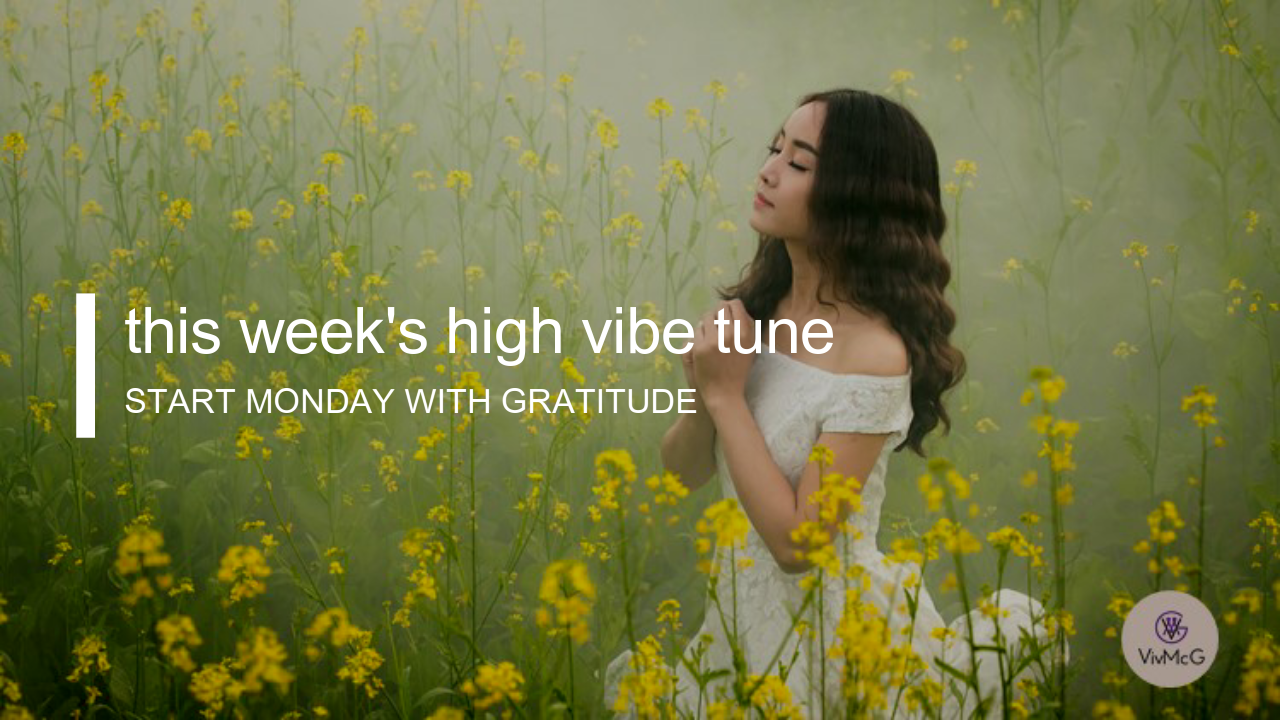
This week's high vibe tune, like this week's quote, focuses on the eyes
have gratitude wherever you go...
... with this week's gratitude quote wallpaper.
Note: details of how to download this week's wallpaper is provided below.
“If there is gratitude in your heart, then there will be tremendous sweetness in your eyes” ~ Sri Chinmoy
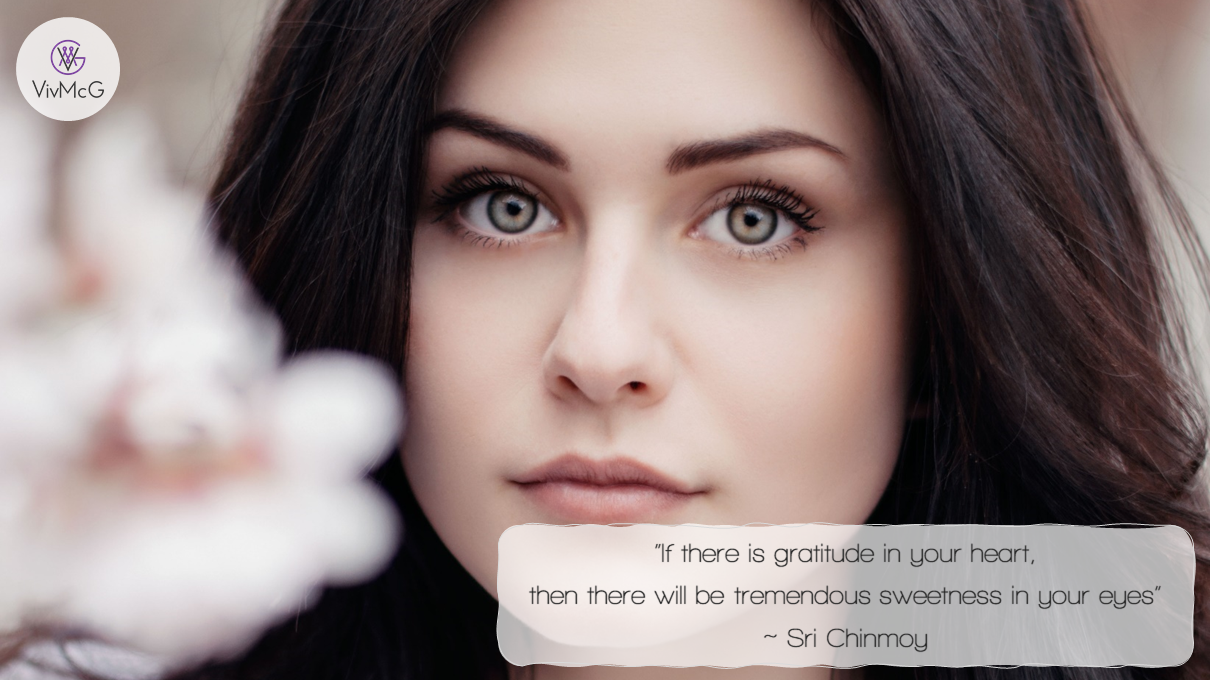
16:9
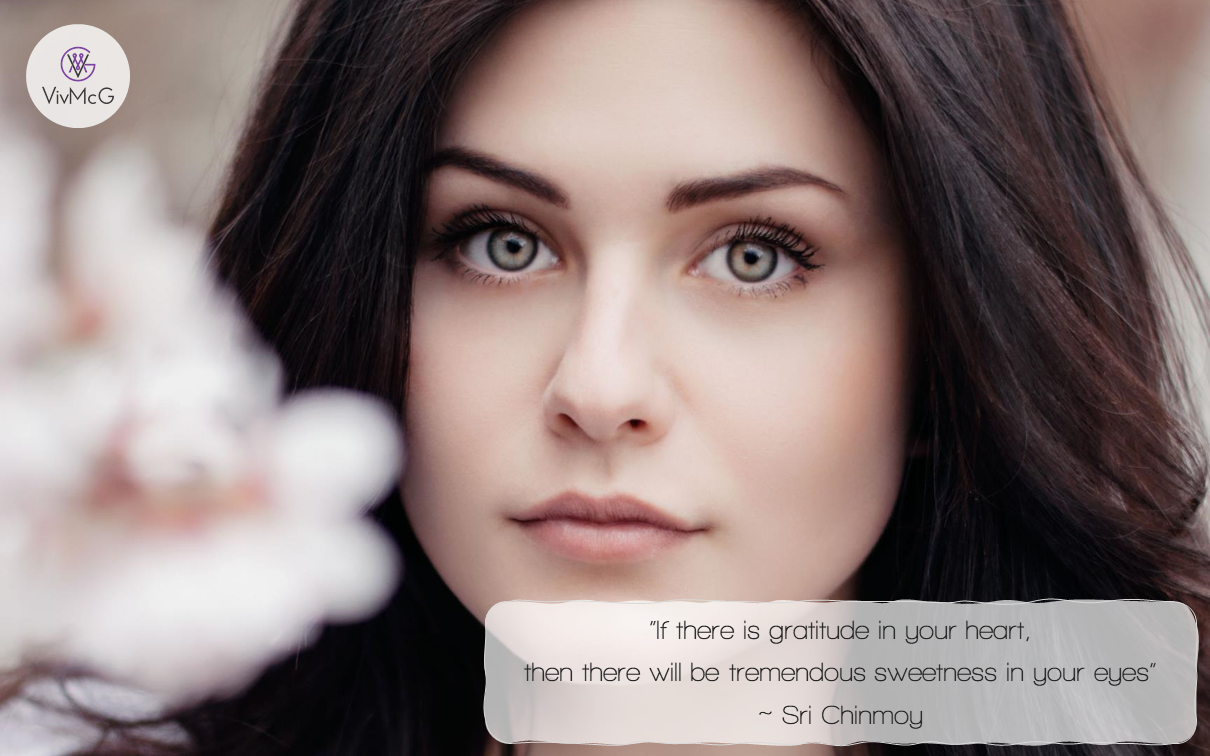
16:10
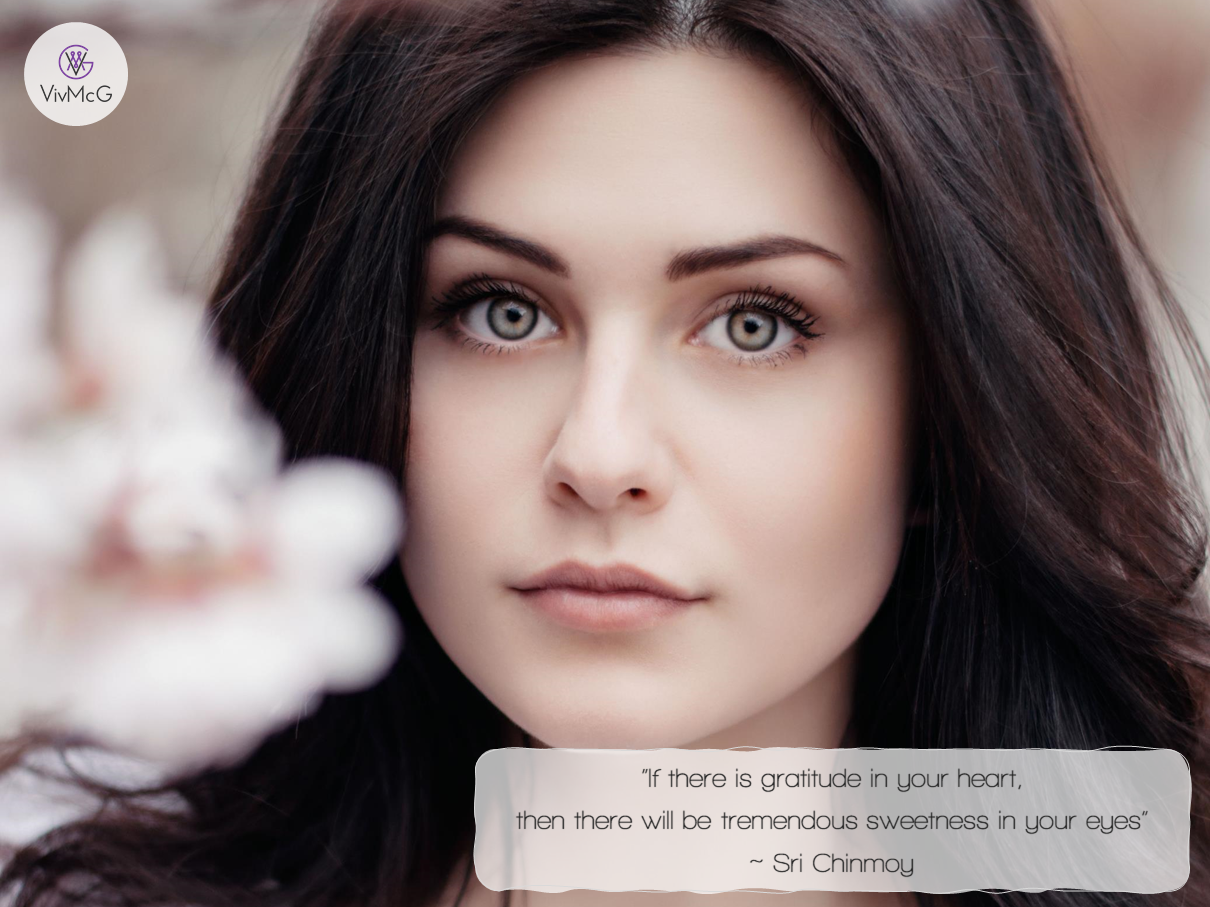
4:3
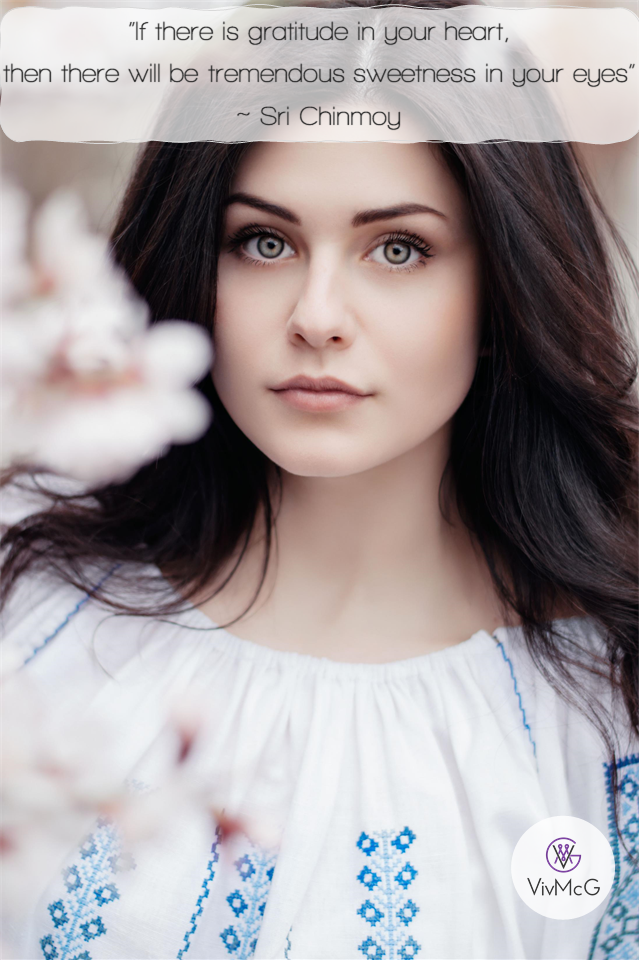
mobile
how to download your wallpaper
desktop
Before copying one of the pictures below, you'll want to quickly check your screen settings because the worst thing you can do is use a wallpaper with an aspect ratio that differs from the aspect ratio of your screen.
The aspect ratio of a rectangle is simply the proportion between width and height. The most common are 16:9, 16:10 and 4:3. And it will be for these 3 sizes that I shall provide you with your free wallpaper.
To find your screen resolution follow this basic guide. Steps for your computer may vary slightly but I hope this will give you some guidance:
- Right-click the desktop and select Display settings.
- Scroll down until you see "Resolution" (you may have to choose an "Advanced" option)
- To find your aspect ratio, divide the width over the height. For example, if my resolution is 1920 x 1080 then I would divide 1920 over 1080 to get 1.778, which indicates a 16:9 resolution. Similarly, 1.6 indicated 16:10 and 1.333 indicates 4:3
- When you've calculated your screen's aspect ratio, go to the picture below that matches that size
- Right click on the picture and select "Set as Desktop Background"
- Choose whether to "Fill", "Fit", or "Stretch" your picture - if you've chosen the right size "Fit" will be your best option
- Select "Set Desktop Background" and you're done
android mobile
- First, save the wallpaper image to your phone by pressing your finger on the wallpaper image and hold down on it until you see a menu.
- From here, click the “Save image” tab, and it will begin downloading.
- The next step is to set this saved image as your wallpaper by pressing and holding a blank area on your screen (meaning where no apps are placed), and home screen options will appear.
- Select 'add wallpaper' and choose whether the wallpaper is intended for 'Home screen', 'Lock screen', or 'Home and lock screen'.
- Another set of options will appear where you can choose where the photo you would like to use will be coming from, namely the Gallery.
- If necessary, crop the image to a suitable size. Once satisfied, simply click 'Done'.
ios smartphone
- First, save the wallpaper image to your phone by pressing your finger on the wallpaper image and hold down for about 2 seconds until a menu appears.
- From here, click “Save Image“, and it will begin downloading.
- The next step is to set this saved image as your wallpaper by, first, going to the 'Photos' app and selecting the wallpaper photo you've saved there.
- Click on the share icon on the lower left corner of the screen, then select 'Use as Wallpaper'.
- Then choose to set the photo as either the lock screen, home screen or both.

